Let Construction Commence for Cell Manufacture
The UK aims high with a new manufacturing center designed to meet the needs of cell and gene therapies

The UK’s Cell Therapy Catapult program has got the ball rolling on a new £55-million manufacturing center designed to “crack the nut” on the scale up, manufacturing and distribution challenges of cell therapies. The aim is to help companies to take their cell therapies from pilot scale to the commercial scale – and the investment comes from Innovate UK, the UK’s innovation agency, after the Cell Therapy Catapult identified a number of gaps hindering cell therapy progress. The center will be located in Stevenage and is set to be fully functional by 2017 – with 5,500m2 of cleanroom space and 12 segregated cleanroom units. We spoke with Matthew Durdy, Chief Business Officer at Cell Therapy Catapult to find out more about the project.
Why is the UK building this center?
The purpose of the center is to fill a missing link in the UK’s cell and gene therapy infrastructure and hopefully put the country in a world-leading position in terms of the manufacture of these new therapies. It will provide a highly cost effective, flexible, GMP grade space where companies can manufacture advanced therapeutics for late stage clinical trials and market supply. It will be an environment where companies can develop their own manufacturing systems prior to building their own facilities. Example projects could be the manufacture of a gene therapy, the manufacture of a T-cell immune therapy for trials, the manufacture of replacement organs and so on.
What are the main challenges when embarking on such an ambitious project?
The main challenge is to ensure the center is carefully constructed to meet the needs of industry and an active dialogue with key industry stakeholders was critical for this. Some of the main requirements from industry were flexibility, transferability of processes, security and segregation, cost effectiveness and the development of a manufacturing cluster around the center. Location was also an important consideration, as cell therapy manufacturing requires streamlined logistics to get patient samples from anywhere in the world to and from the manufacturing center quickly, as they have a short shelf life.
And what are your personal hopes and predictions for the cell and gene therapy industry?
Some of the products in clinical trials for cell therapy demonstrate real efficacy. For example, in some of the immuno-oncology CD19 targeting products, we are seeing more than 80 percent complete response rates in relapsed and refractory patients. This is – and I don’t use this word lightly – an unprecedented step up in efficacy. And I may be biased but I really believe that the UK has a fantastic science base and innovation in cell and gene therapy – the area is seeing a lot of support from the UK’s regulators, payers and government. We’d like the UK to be a go-to place internationally for cell and gene therapies. This new center will be well ahead in terms of timing, scale and operational innovation of any other center around the world with cell and gene therapy manufacturing capabilities.



















